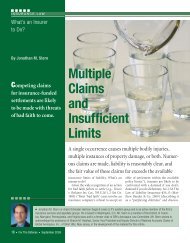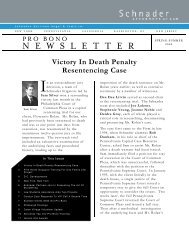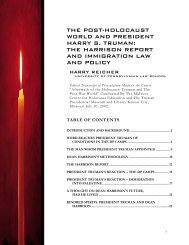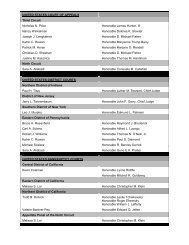Filed the first CD-ROM brief in the U.S. Supreme Court - Schnader ...
Filed the first CD-ROM brief in the U.S. Supreme Court - Schnader ...
Filed the first CD-ROM brief in the U.S. Supreme Court - Schnader ...
Create successful ePaper yourself
Turn your PDF publications into a flip-book with our unique Google optimized e-Paper software.
First <strong>CD</strong>-<strong>ROM</strong> Brief Accepted by <strong>Supreme</strong> <strong>Court</strong><br />
Page 19 of 31<br />
The Internet is a powerful teach<strong>in</strong>g and research tool. In universities, for example, professors use <strong>the</strong><br />
Internet to supplement pr<strong>in</strong>ted materials available to students, some of whom are m<strong>in</strong>ors, <strong>in</strong> order to<br />
offer more comprehensive treatment of facts and issues. The ready access to <strong>in</strong>formation made possible<br />
by <strong>the</strong> Internet, <strong>in</strong> addition to smaller local area networks with<strong>in</strong> university communities, enhances <strong>the</strong><br />
educational experience. Professors use <strong>the</strong> Internet not only to teach courses cover<strong>in</strong>g <strong>the</strong> subjects<br />
discussed <strong>in</strong> <strong>the</strong> forego<strong>in</strong>g sections of this <strong>brief</strong> — for example, medic<strong>in</strong>e, anatomy, biology, art, social<br />
work, journalism, and human rights — but also courses on such issues as <strong>the</strong> social and psychological<br />
effects of pornography and <strong>the</strong> philosophical implications of cyberspace. This is accomplished by<br />
post<strong>in</strong>g course materials on Web sites; transmitt<strong>in</strong>g, via e-mail, <strong>in</strong>formation located elsewhere on <strong>the</strong><br />
Internet; encourag<strong>in</strong>g students to explore <strong>the</strong> <strong>in</strong>formation available on <strong>the</strong> Internet <strong>in</strong> a particular subject<br />
area; and, <strong>in</strong> many cases, by a comb<strong>in</strong>ation of all of <strong>the</strong>se methods. And as discussed later <strong>in</strong> this <strong>brief</strong>,<br />
professors also utilize <strong>the</strong> Internet <strong>in</strong> <strong>the</strong>ir own research and to communicate and exchange <strong>in</strong>formation<br />
with <strong>the</strong>ir colleagues at o<strong>the</strong>r <strong>in</strong>stitutions.<br />
[P. 27]<br />
For example, amicus Peter Ludlow, an Associate Professor at <strong>the</strong> State University of New York at Stony<br />
Brook, places onl<strong>in</strong>e all of his course materials for his course, entitled "Conceptual Issues <strong>in</strong><br />
Cyberspace." The course covers, <strong>in</strong> an onl<strong>in</strong>e context, such issues as <strong>the</strong> nature of onl<strong>in</strong>e sexual behavior<br />
<strong>in</strong> multi-user onl<strong>in</strong>e games known as "muds." The very reason that some materials are used <strong>in</strong> <strong>the</strong> course<br />
is that <strong>the</strong>y are construed by some as "<strong>in</strong>decent," and an analysis of that construction is part of what <strong>the</strong><br />
course addresses. Transmitt<strong>in</strong>g <strong>the</strong>se materials, even <strong>in</strong> <strong>the</strong> context of provid<strong>in</strong>g a comprehensive<br />
academic analysis, may itself be construed "<strong>in</strong>decent" and, <strong>the</strong>refore, crim<strong>in</strong>alized by <strong>the</strong> <strong>CD</strong>A.<br />
Certa<strong>in</strong>ly <strong>the</strong> wide-sweep<strong>in</strong>g <strong>CD</strong>A does not provide for consideration of <strong>the</strong> context <strong>in</strong> which materials<br />
are placed on <strong>the</strong> Internet. For that reason, Professor Ludlow chose to change his approach to us<strong>in</strong>g<br />
onl<strong>in</strong>e course material for his class last semester on moral reason<strong>in</strong>g as applied to <strong>the</strong> Internet, which<br />
<strong>in</strong>cluded materials actually subject to censorship and thus considered by some to be "<strong>in</strong>decent" or<br />
"patently offensive" per se. While most of <strong>the</strong> read<strong>in</strong>gs for <strong>the</strong> course were made available onl<strong>in</strong>e,<br />
Professor Ludlow felt unable to provide onl<strong>in</strong>e copies of <strong>the</strong> more controversial materials, concerned<br />
that if <strong>the</strong> <strong>CD</strong>A were <strong>in</strong> effect he could be subject to prosecution under its provisions for his teach<strong>in</strong>g<br />
activities.<br />
The <strong>CD</strong>A <strong>the</strong>refore poses a threat to academic freedom, which requires broad latitude for teach<strong>in</strong>g and<br />
research <strong>in</strong> <strong>the</strong> pursuit of truth and knowledge. See, e.g., Keyishian v. Board of Regents of University of<br />
State of New York, 385 U.S. 589, 603 (1967) (recogniz<strong>in</strong>g importance of academic freedom to<br />
democracy). The 1940 Statement of Pr<strong>in</strong>ciples on Academic Freedom and Tenure, adopted 57 years ago<br />
by amicus American Association of University Professors and endorsed by more than 150 professional<br />
organizations and learned societies, applies fully and forcefully <strong>in</strong> <strong>the</strong> context of <strong>the</strong> Internet of <strong>the</strong><br />
1990s: "Freedom <strong>in</strong> research is fundamental to <strong>the</strong> advancement of truth. Academic freedom <strong>in</strong> its<br />
teach<strong>in</strong>g aspect is fundamental for <strong>the</strong> protection of <strong>the</strong> rights of <strong>the</strong> teacher <strong>in</strong> teach<strong>in</strong>g and of <strong>the</strong><br />
student to freedom <strong>in</strong> learn<strong>in</strong>g." AAUP Policy Documents [P. 28] & Reports (1995 ed.); see<br />
http://www.schnader.com/91.htm (Exhibit 33). The crim<strong>in</strong>al proscriptions of <strong>the</strong> <strong>CD</strong>A would eviscerate<br />
vast realms of teach<strong>in</strong>g and learn<strong>in</strong>g materials, to <strong>the</strong> detriment of both teachers and students, both adults<br />
and m<strong>in</strong>ors.<br />
The <strong>CD</strong>A also stifles access to <strong>in</strong>formation available <strong>in</strong> libraries, <strong>in</strong>clud<strong>in</strong>g those affiliated with<br />
<strong>in</strong>stitutions of higher learn<strong>in</strong>g. "A library is a mighty resource <strong>in</strong> <strong>the</strong> free market place of ideas. It is<br />
specially dedicated to <strong>the</strong> broad dissem<strong>in</strong>ation of ideas. It is a forum for silent speech." M<strong>in</strong>arc<strong>in</strong>i, 541<br />
F.2d at 582-83 (citations omitted). Yet, while materials available <strong>in</strong> pr<strong>in</strong>t form are fully accessible to<br />
m<strong>in</strong>ors and adults, <strong>the</strong> <strong>CD</strong>A prohibits <strong>the</strong> same access on <strong>the</strong> Internet. And, while a library has <strong>the</strong><br />
freedom to choose what books and periodicals to <strong>in</strong>clude <strong>in</strong> its collection, so that it can identify and<br />
file://C:\Documents and Sett<strong>in</strong>gs\u0072943\Desktop\Brief.htm<br />
7/11/2008







